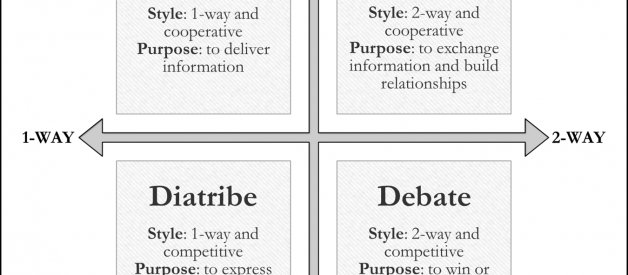 The Four Types of Conversations
The Four Types of Conversations
When talking with someone, it is helpful to know what type of conversation you are in. You can do so based on a conversation?s direction of communication (a one-way or two-way street) and its tone/purpose (competitive or cooperative).
If you are in a one-way conversation, you are talking at someone, rather than with someone. If you are in a two-way conversation, participants are both listening and talking. In a competitive conversation, people are more concerned about their own perspective, whereas in a cooperative conversation participants are interested in the perspective of everyone involved.
Based on direction and tone, I grouped conversations into four types: debate, dialogue, discourse, and diatribe.
- Debate is a competitive, two-way conversation. The goal is to win an argument or convince someone, such as the other participant or third-party observers.
- Dialogue is a cooperative, two-way conversation. The goal is for participants to exchange information and build relationships with one another.
- Discourse is a cooperative, one-way conversation. The goal to deliver information from the speaker/writer to the listeners/readers.
- Diatribe is a competitive, one-way conversation. The goal is to express emotions, browbeat those that disagree with you, and/or inspires those that share the same perspective.
To highlight the differences between these types of conversations, let?s use politics as an example:
- Debate: two family members from opposite sides of the political spectrum arguing over politics.
- Dialogue: two undecided voters talking to each other about the candidates, trying to figure out who they want to vote for.
- Discourse: a professor giving a lecture on international affairs.
- Diatribe: a disgruntled voter venting about the election?s outcome.
It is important to know which type of conversation you are in, because that determines the purpose of that conversation. If you can identify the purpose, you can better speak to the heart of that conversation. But, if you misidentify the conversation you are in, you can fall into conversational pitfalls.
Here are a few examples of conversational pitfalls I?ve written about:
- ?Talking At, Not With: The Problem of Disconnected Conversations? ? sometimes your dialogue might actually be two separate discourses (or diatribes) instead; will you recognize that in time?
- ?When Arguing Over Value Issues, Sometimes Facts and Truth Don?t Matter? ? sometimes people just want to diatribe; what can you do when that happens, especially when you want to have a dialogue or debate?
If someone appears to be in a conversational pitfall, you can help them climb back out. Regardless of how one climbs back out, the solution always starts with identifying which hole you are in. You must first know the problem before you can find the solution. And, sometimes, just identifying the pitfall itself is enough to draw attention to the problem and correct the conversation.
Parting Thoughts
When you are in a conversation, take a moment to think about which conversation you are actually in. Each of the types of conversation are meaningless on their own; you give them meaning in their use. And, ultimately, it is up to you to decide what type of conversation you want to be part of.
While this article is a discourse (I?ve been writing, you?ve been reading) it doesn?t have to remain that way. Feel free to like, comment, or share before you leave. For more, check out davidwangel.com.


